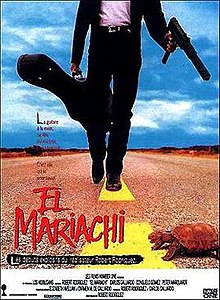This article may need to be rewritten to comply with Wikipedia's quality standards. (May 2019) |
Mexploitation (sometimes called Cabrito Western[1] or Mexican video-home)[2] is a film genre of low-budget films that combine elements of an exploitation film and Mexican culture or portrayals of Mexican life within Mexico often dealing with crime, drug trafficking, money and sex.

Mexican narco-cinema
editThe Mexican narco-cine (Spanish for narco-cinema)[3] or narco-películas (Spanish for narco-films/narco-movies),[4] are a subgenre of the Mexploitation style films,[5] focused solely on the violence and luxurious lives of drug lords and cartels.[6] The title and the storyline of these films are usually inspired by popular narco corridos (drug ballads, drug songs),[7] and are marketed as low budget[8] tie-in merchandising to the narcocorrido songs.[9] Sometimes these films feature famous narco-corrido singers on them,[10] and are rumored to be financed by drug lords themselves. However, only a few such cases have been proven.[11]
Common qualities
editMexploitation movies made in the 1960s and 1970s in Mexico were closer to their American exploitation film counterparts, with low-budget science-fiction films that often starred Mexican luchadores such as El Santo and Huracan Ramirez.
In the early 1980s and 1990s there was a notable change with films increasingly dealing with real-life issues such as drug cartels and the murders of their rivals. Notable actors in these films include Mario Almada,[12]: 15 Hugo Stiglitz,[13]: 123 Sergio Goyri, Valentin Trujillo, Jorge Reynoso,[12]: 15 Rodolfo de Anda,[13]: 79 Fernando Almada,[14] Rosa Gloria Chagoyán[14] and David Reynoso.[15]
The director Robert Rodriguez has been considered a pioneer of Mexploitation in the United States. His first film, El Mariachi, contains many Mexploitation elements and his 2007 film, Planet Terror, contained a fake trailer which developed into a feature film called Machete (2010), which contains many familiar elements of the genre.[16]
K. Gordon Murray
editExploitation film producer and distributor named K. Gordon Murray acquired a unique collection of horror films in Mexico which began to appear on American late-night television and drive-in screens in the 1960s.[17][18] Ranging from monster movies clearly owing to the heyday of Universal Studios, to the lucha libre horror films featuring El Santo[19] and the "Wrestling Women"[20] alongside the 1959 Christmas classic "Santa Claus",[21] these low-budget films are still notably campy and inspired a small cult following.[20]
See also
editReferences
edit- ^ "Pistoleros famosos revela la identidad regional". Milenio. 12 November 2013.
- "El Cabrito-Western". Archived from the original on 2016-09-16. Retrieved 2016-04-18.
- "El cine cabrito". CONTRALINEA.COM.MX - Periodismo de investigación. April 2011. - ^ "Sangre, apuros y chingadazos: ¡viva el videohome mexicano!". VICE. 10 June 2014.
- ^ "Mexican Narco Cinema - VICE - México". VICE. 29 March 2010.
- ^ "El Universal - Espectáculos - Millones de latinos compran narcopelículas". El Universal. 11 August 2015.
- ^ Rashotte, Ryan (23 April 2015). Narco Cinema. Springer. ISBN 9781137489241.
- "Cinefagia y Cinegarage te invitan al taller "Bizarre cinema. El lado oscuro del cine", en Cine Tonalá. INSCRIPCIONES ABIERTAS". revistacinefagia.com. - ^ "BBC Mundo - Noticias - México: la violencia del narco, al cine".
- ^ Micaela Arroyo (22 April 2014). "Tijuana, la meca del 'narcocine'". Milenio.
-"CorridosAlterados.Net".
-"Narco Peliculas". - ^ "Actué en una película de 'narcotraficantes'". diez4.com. 18 January 2017.
- ^ "Fabián López - IMDbPro".
-"El Universal - - Pozolero y Muletas, estrellas de narcofilm". 18 June 2013. - ^ Alex Tieleman (25 September 2011). "Alfredo Ríos, "El Komander", la voz de los narcocorridos mexicanos".
- ^ "El Universal - Espectáculos - 'Narcos fueron actores'". El Universal. 3 September 2015.
- "'La Barbie' habla de otros capos y de la película inspirada en él". - ^ a b Rashotte, Ryan (2015-04-23). Narco Cinema: Sex, Drugs, and Banda Music in Mexico's B-Filmography. Springer. ISBN 978-1-137-48924-1.
- ^ a b Conway, Christopher (2019-12-15). Heroes of the Borderlands: The Western in Mexican Film, Comics, and Music. University of New Mexico Press. ISBN 978-0-8263-6111-0.
- ^ a b Rohrer, Seraina (2017-12-20). La India María: Mexploitation and the Films of María Elena Velasco. University of Texas Press. ISBN 978-1-4773-1347-3.
- ^ Mora, Carl J. (2015-05-07). Mexican Cinema: Reflections of a Society, 1896-2004, 3d ed (in Arabic). McFarland. ISBN 978-0-7864-9187-2.
- ^ Aldama, Frederick Luis (2015-03-15). Critical Approaches to the Films of Robert Rodriguez. University of Texas Press. pp. 157–163. ISBN 978-0-292-76357-9.
- ^ Senn, Bryan (2019-02-28). "Twice the Thrills! Twice the Chills!": Horror and Science Fiction Double Features, 1955-1974. McFarland. p. 309. ISBN 978-1-4766-3571-2.
- ^ Schneider, Steven Jay; Williams, Tony (2005). Horror International. Wayne State University Press. p. 13. ISBN 978-0-8143-3101-9.
- ^ Greene, Doyle (2015-01-28). Mexploitation Cinema: A Critical History of Mexican Vampire, Wrestler, Ape-Man and Similar Films, 1957-1977. McFarland. p. 37. ISBN 978-1-4766-0072-7.
- ^ a b Cotter, Robert Michael “Bobb” (2015-06-14). The Mexican Masked Wrestler and Monster Filmography. McFarland. p. 141. ISBN 978-1-4766-0419-0.
- ^ Craig, Rob (2019-02-15). American International Pictures: A Comprehensive Filmography. McFarland. ISBN 978-1-4766-3522-4.